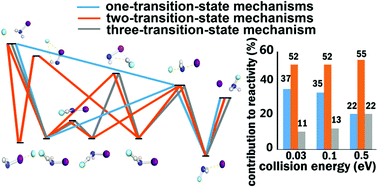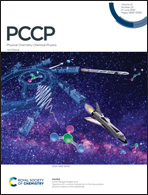The importance of the composite mechanisms with two transition states in the F− + NH2I SN2 reaction†
Abstract
The dynamics of the bimolecular nucleophilic substitution (SN2) reactions at nitrogen are less understood than those of their corresponding reactions at carbon. In this paper, we report an ab initio molecular dynamics approach to investigate the reaction mechanisms of the F− + NH2I SN2 reaction at nitrogen. We found not only the one-transition-state mechanisms, but also the composite mechanisms with two and three transition states. For the two-transition-state mechanisms, the double inversion mechanism and the proton-abstraction roundabout followed by the backside-attack reaction mechanism have been reported before; but we discovered that there is also a new, front-side attack followed by the backside-attack Walden-inversion mechanism. Furthermore, a composite mechanism with three transition states also shows up in the reactive trajectories. Our results show that, as the collision energy increases, the SN2 reactivity decreases, and the proton-abstraction reactivity increases. The two-transition-state mechanisms, especially the double-inversion mechanism, make the largest contribution to the SN2 reactivity, followed then by the one-transition-state mechanisms, with the three-transition-state mechanism contributing the least. The potential energy profiles of the reaction mechanisms are characterized at the CCSD(T)/aug-cc-pVTZ(PP) level of theory. The analysis on stationary points shows that the proton-abstraction inversion transition state is ∼12.4 kcal mol−1 lower than the Walden-inversion transition state in contrast to the corresponding reaction at carbon F− + CH3I, in which the former is ∼26.1 kcal mol−1 higher than the latter. This might explain why the composite mechanism of the double inversion mechanism contributes the most to the SN2 reactivity in the F− + NH2I reaction.

- This article is part of the themed collection: 2020 PCCP HOT Articles


 Please wait while we load your content...
Please wait while we load your content...